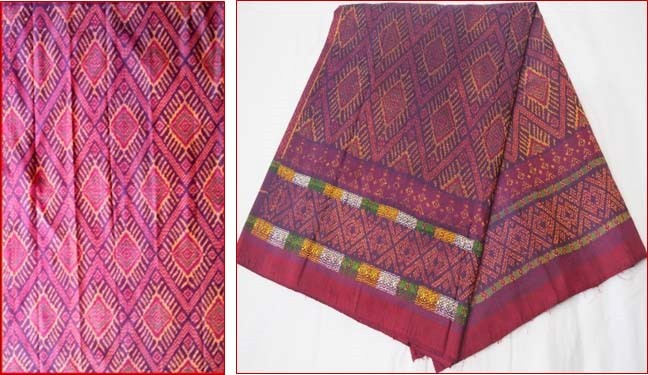การพัฒนาโปรแกรมออกแบบลายผ้าเพื่อการสร้างสรรค์และสืบสานภูมิปัญญาผ้าไทย
Main Article Content
Abstract
Chusak Yathongchai and Wilairat Yathongchai
รับบทความ: 9 กุมภาพันธ์ 2565; แก้ไขบทความ: 6 กรกฎาคม 2565; ยอมรับตีพิมพ์: 12 กรกฎาคม 2565; ตีพิมพ์ออนไลน์: 14 พฤศจิกายน 2565
บทคัดย่อ
การวิจัยนี้มีวัตถุประสงค์เพื่อพัฒนาและศึกษาการใช้งานโปรแกรมในการออกแบบลายผ้า ที่พัฒนาขึ้นตามวงจรการพัฒนาระบบ บนแนวคิดการเขียนโปรแกรมเชิงวัตถุ ด้วย Microsoft Visual Studio C#.NET ที่มีเครื่องมือช่วยในการออกแบบลายผ้าด้วยวิธีการสร้างลายด้วยมือเปล่า และการสืบค้นจากฐานข้อมูล ผลการวิจัยพบว่าโปรแกรมมีการทำงานหลัก 2 ส่วนคือ ส่วนสร้างและแก้ไขลายผ้า ที่มีฟังก์ชันการทำงานในการสร้าง แก้ไข คัดลอกลาย การนำรูปภาพรวมถึงลายเดิมมาสร้างเป็นลายใหม่ และส่วนแสดงภาพจำลองของผ้า ที่แสดงภาพจำลองผ้าตามลายที่ออกแบบ สีเส้นยืน จำนวนเส้นพุ่งที่ต้องการ และมีเครื่องมือพิมพ์ลายสำหรับใช้ประกอบการมัดหมี่ ย้อมสี และทอผ้าออกทางเครื่องพิมพ์ จากการทดสอบการใช้โปรแกรมกับกลุ่มทอผ้าจังหวัดบุรีรัมย์ พบว่า 1) ผลการออกแบบลาย สมาชิกสามารถสร้างสรรค์ลวดลายใหม่ได้อย่างไม่จำกัด และสามารถนำลายผ้าเดิมของชุมชนมาทำการแกะลายและบันทึกไว้ในรูปไฟล์ดิจิทัลได้ มีผลการประเมินคุณภาพการออกแบบลายโดยผู้เชี่ยวชาญ ในความถูกต้องของจำนวนลำ ความถูกต้องของตำแหน่งลาย ขนาดของลาย และลักษณะของโครงสร้าง/รูปทรงของลายมีคุณภาพอยู่ในระดับมากที่สุด ส่วนสีสันของลายเป็นไปตามที่ออกแบบมีผลการประเมินอยู่ในระดับมาก และ 2) ผู้ใช้มีความพึงพอใจในการใช้งานโปรแกรมอยู่ในระดับมากที่สุด ทั้งในส่วนแสดงผลและพิมพ์ลายผ้า ส่วนออกแบบลายผ้า และภาพรวมการออกแบบโปรแกรม
คำสำคัญ: โปรแกรมออกแบบลายผ้า การสร้างสรรค์ลายผ้าไทย การสืบสานลายผ้าไทย ภูมิปัญญาผ้าไทย
Abstract
This research aimed to develop and study the Textile Design program to design fabric patterns. The program has been developed according to the system development life cycle based on the concept of object–oriented programming using the Microsoft visual studio C#. NET. It has the tools to design fabric patterns with freehand editing and findings in databases. The results showed that the program had two major parts: 1) creating and editing pattern part, it had the functions to create, edit, copy, and import images, including the original patterns to create a new one; and 2) the part of fabric simulation image preview, it displayed fabric simulation images according to the designed patterns, warp colors, and number of wefts that were required. It also included a tool to print the patterns for tying, dyeing, and weaving processes. From testing the use of the program by the weaving groups in Buriram, the findings were as follows: 1) the pattern design results: the members could create an unlimited number of new designs. They could also copy the original patterns of their community and save them as digital files. The quality assessment results of the pattern designs by the experts in the accuracies of thread count, pattern position, size of the patterns, and characteristics of the pattern structures/shapes were at the highest level. The results of similarity evaluation between the fabric pattern colors and the designed colors were at a high level; and 2) the users were satisfied with the use of the program at the highest level in the pattern display and print part, the pattern design part, and the overall program design.
Keywords: Fabric pattern design program, Creation of Thai fabric pattern, The continuation of Thai fabric pattern, Thai fabric wisdom
Downloads
Article Details

This work is licensed under a Creative Commons Attribution-NonCommercial 4.0 International License.
References
Chaiyachotanan, J. (2013). The Legend of Buriram Silk. Bangkok: I Print & Tech-nology (Thailand). (in Thai)
Dononbao, C. and Peerasan, J. (2020). Innovation of development in the hand woven cotton of the local identity in Loei province. Journal of Fine and Applied Arts Khon Kaen University 12(2): 22–42. (in Thai)
Friske, M., Wu, S., and Devendorf, L. (2019). AdaCAD: Crafting software for smart tex-tiles design. In Proceedings of the 2019 CHI Conference on Human Factors in Computing Systems (pp. 1–3). ACM, 345.
Irene Posch. (2017). Crafting tools. Interac-tions 24(2): 78–81.
Jitmanas, A., Ruksachol, O., Rittichoui, R., Intarapak, W., and Puangchon, D. (2017). The creation and design of the pattern of NaKhon's Brocade silk by mathematics program to support community’s career. Proceedings of 4th Petchaburi Rajabhat National Academic (pp.88–92). Petcha-buri: Petchaburi Rajabhat University. (in Thai)
Lek–Uthai, J., and Panityotai, J. (2011). Development of a Jok designing program. Thai Science and Technology Journal (TSTJ) 19(2): 75–80. (in Thai)
Lingel, J., and Regan, T. (2014). “It's in your spinal cord, it's in your fingertips”: Prac-tices of tools and craft in building soft-ware. In Proceedings of the 17th ACM Conference on Computer Supported Cooperative Work & Social Computing (CSCW’14) (pp.295–304). ACM New York, NY, USA.
Office of the National Economic and Social Development Council. (2021). The Twelfth National Economic and Social Development Plan (2017–2021). Retrieved from https://www.nesdc.go.th/ewt_news.php?Nid=6420&filename=develop_issue, September 10, 2021. (in Thai)
Potiyaraj, P., and Udomkichdecha, W. (2006). 3D Simulation of Woven Structures by Virtual Reality Modeling Language. Bangkok: Chulalongkorn University. Retrieved from https://doi.nrct.go.th/ListDoi/listDetail? Resolve_DOI=10.14457/CU.res.2006.2, September 20, 2021. (in Thai)
Pratwet, P., Sriboonruang, Y., Manenin, N., and Rojanasang, C. (2018). Silk cloth, cotton fiber: From local wisdom to Sisaket identity. Journal of Humanities and Social Sciences Mahasarakham University 37(5): 109–118. (in Thai)
Ruxpakawong, U. (2014). The Wale Image Analysis of Woven Clothes (JOK and KHID) by the Computer Program Using as Woven–handed Prototype of Phitsanulok Province. Phitsanulok:Pibulsongkram Rajabhat University. (in Thai)
Saiyakit, P., Khiaomang, K., and Nisamanee, N. (2015). A study of graphics design pattern Mudmee silk, Chonnabot District, Khonkaen province for product design. Art and Architecture Journal Naresuan University 6(2): 148–164. (in Thai)
Thitikunperom, T. (2010). The Creation of Mudmee Pattern by the Use of Graphic–Based Device. Master of Fine Art Thesis (Visual Arts). Bangkok: Silpakorn University. (in Thai)
Vongpramate, D., Hobantud, S., and Prajonsant, S. (2018). Development of simulation software for mudmee silk from Buriam local wisdom. Thai Science and Technology Journal (TSTJ) 26(7) (Sup-plement issue 2018): 1264–1272. (in Thai)
Yathongchai, C., Chaiyachotanan, J., Yathongchai, W., Rachprakhon, P., and Klongchai, A. (2019). Creating Identity Fabric Patterns of Khmer Ethnic for Premium Product Development of Sanuan Nok Thai Silk Village, Huai Rat, Buriram. Buriram: Buriram Rajabhat University. (in Thai)
